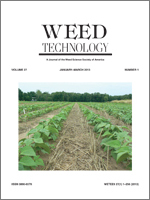Field studies were conducted to determine the effect of halosulfuron at 0, 13, 26, 39 or 52 g ha−1 applied 10, 22, and 31 d after planting (DAP) on ‘Beauregard' and ‘Covington' sweetpotato. Storage roots were harvested, graded, cured, and stored in controlled environment for 2 mo. Where injury on storage roots was observed, external injury occurred on the surface of the storage root as a blackened area with blistering and internal injury consisted of small red-brown spots inside the sweetpotato storage root. Total yield of sweetpotato with 13 g ha−1 halosulfuron treatment (155,157 kg ha−1) was similar to the nontreated check (162,002 kg ha−1). However, halosulfuron rates above 13 g ha−1 resulted in a reduction of marketable grade roots and total yield of sweetpotato. Regardless of rate and timing of halosulfuron, external and internal injury to Beauregard storage roots was less than 6 and 9%, respectively. No external injury to Covington was observed from all rates of halosulfuron applied POST at 10 DAP. Halosulfuron at 22 DAP to Covington caused greater external injury to storage roots than was observed on the nontreated. Thus, Beauregard appears more tolerant to halosulfuron POST than Covington. To minimize internal or external injury to storage roots of Covington, halosulfuron must be applied within 10 DAP.
Nomenclature: Halosulfuron; sweetpotato, Ipomoea batatas (L.) Lam. ‘Beauregard' and ‘Covington'.
Se realizaron experimentos de campo para determinar el efecto de halosulfuron a 0, 13, 26, 39 ó 52 g ha−1 aplicados 10, 22 y 31 d después de la siembra (DAP) en batata 'Beauregard' y 'Covington'. Raíces de almacenamiento fueron cosechadas, evaluadas según su calidad, curadas y almacenadas en un ambiente controlado por 2 meses. Cuando se observó daño en las raíces de almacenamiento, se vio un daño externo en la superficie de la raíz con un área ennegrecida con ampollas, mientras que el daño interno consistió en puntos café-rojizo dentro de la raíz de almacenamiento de la batata. El rendimiento total de la batata del tratamiento con 13 g ha−1 de halosulfuron (155,157 kg ha−1) fue similar al testigo no tratado (162,002 kg ha−1). Sin embargo, dosis de halosulfuron por encima de 13 g ha−1 resultaron en una reducción del rendimiento total y de las raíces de batata con calidad comercializable. Sin importar la dosis o el momento de aplicación de halosulfuron, el daño externo e interno en las raíces de almacenamiento de Beauregard fue menor al 6 y 9%, respectivamente. No se observó daño externo en Covington en ninguna de las dosis aplicadas POST 10 DAP. Halosulfuron aplicado 22 DAP, causó un daño externo mayor en las raíces de almacenamiento de Covington que el daño observado en el testigo no tratado. Así, Beauregard parece ser más tolerante a halosulfuron POST que Covington. Para minimizar daños internos o externo en las raíces de almacenamiento de Covington, se debe aplicar halosulfuron dentro de los 10 DAP.





